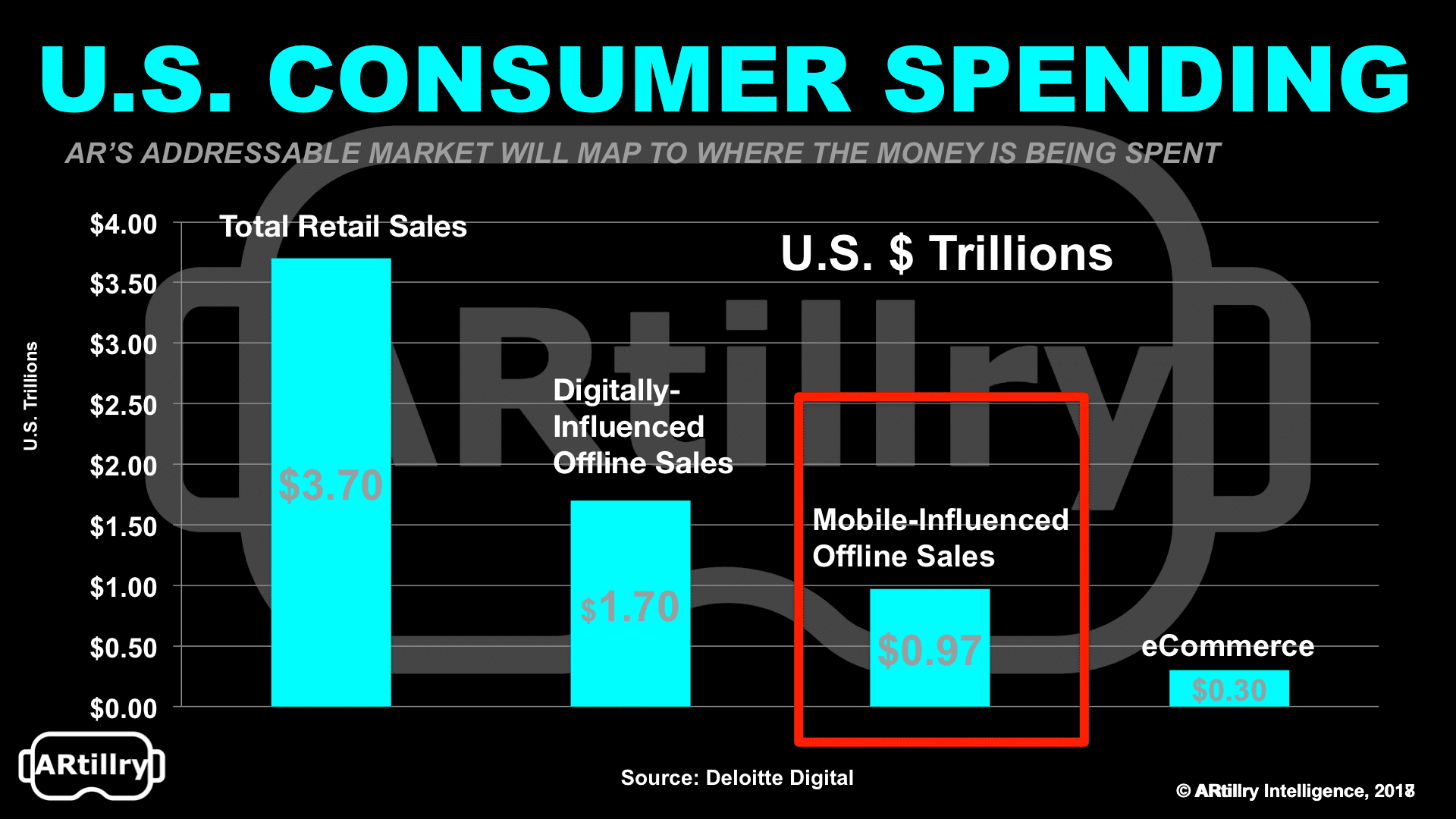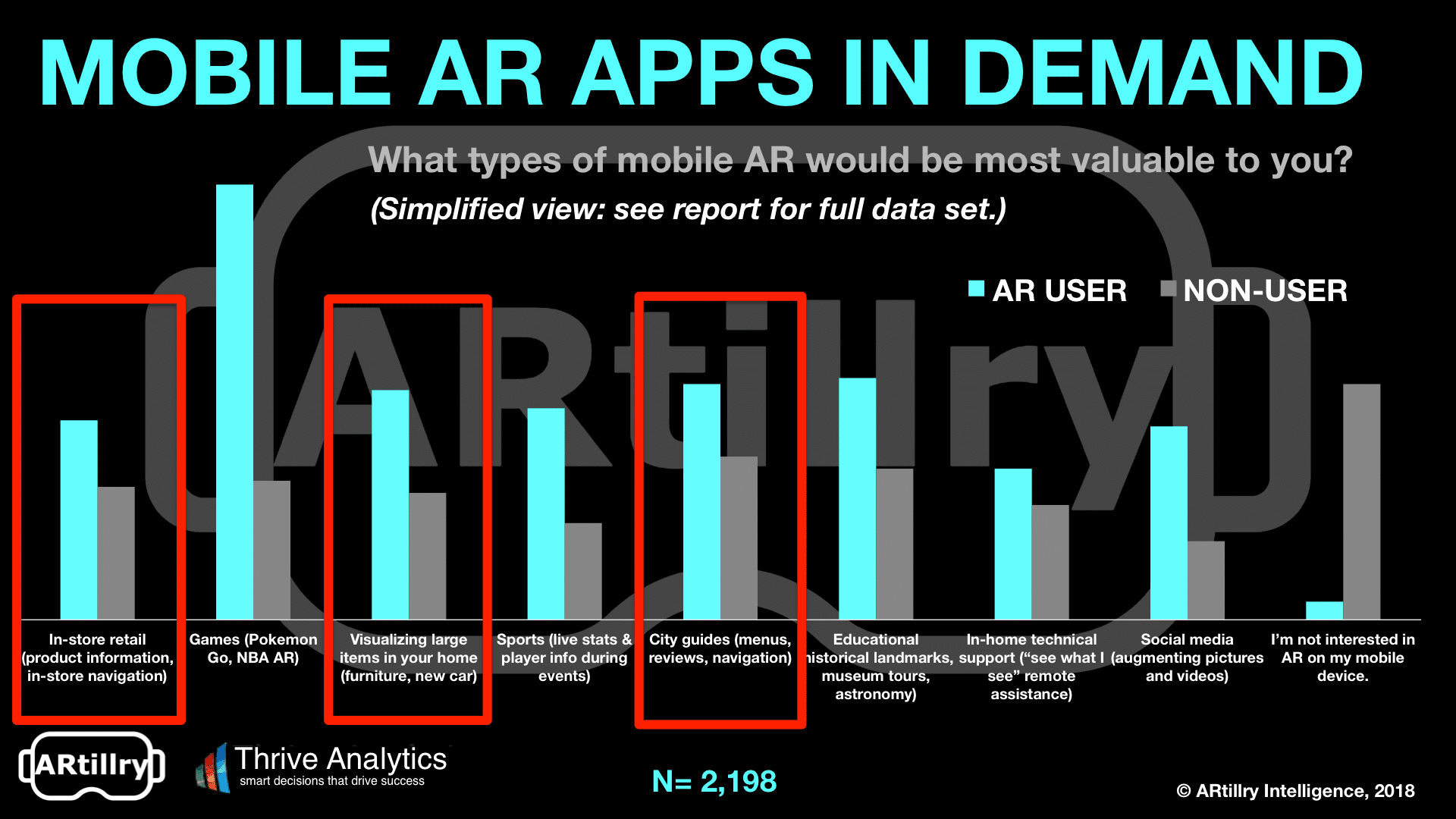
This post is adapted from ARtillry’s latest Intelligence Briefing, The Camera is the New Search Box: Ads in AR. It includes some of its data and takeaways. More can be previewed here and subscribe for the full report.
Most AR ad campaigns involve ads that are pushed to users in targeted ways. These are analogous to today’s display ads, and even piggyback on exiting display channels and tactics like Facebook News Feed ads and Snapchat lenses (see our case studies last week).
But beyond that push format, what about the advertising world’s other modality: pull. We’re of course referring to search. It’s a $90 billion industry, whose success is driven by contextual relevance and alignment with user intent. That’s because users explicitly indicate a need.
This push vs. pull delineation will play into AR advertising’s evolution. Just as the web started with display ads before search (GoTo.com, Overture, Google Page Rank, etc.), a similar progression will happen in AR. That’s why the ads are display-heavy in AR’s early days.

But search will gain prominence in AR in native fit and in dollars. If you think about it, AR is inherently a form of search. But instead of typing or tapping search queries in the traditional way, the search input is your phone’s camera and the search “terms” are physical objects.
The way this is taking shape is “visual search.” Represented best by Google Lens, users point their phones at items to retrieve information (or transact). Its use cases and product categories will develop (think: electronics and apparel), but could be almost as broad as search itself.
“A lot of the future of search is going to be about pictures instead of keywords,” Pinterest CEO Ben Silberman said recently. His claim underscores a key factor that indicates visual search’s potential: millennials. The buying-empowered generation has a high affinity for the camera.

Google Lens: Highly Motivated
These are some reasons why Google is keen on AR. As with all its XR initiatives, Google’s AR efforts are driven to advance its core business. To continue dominating and deriving revenue from search, Google must establish its place in this next visual iteration of the medium.
“Think of the things that are core to Google, like search and maps,” said Google XR Partnership Lead Aaron Luber at ARiA. “These are core things we are monetizing today and see added ways that we can use [AR]. All the ways we monetize today will be ways we think about monetizing AR.”
For example, a key search metric is query volume (along with cost-per-click, click-through-rate and fill rates). Visual search lets Google capture more “queries” when consumers want information. And these out-of-home moments are valuable and “high intent” (more on that in a bit).
These aspirations will manifest initially in Google Lens. Using Google’s vast image database and knowledge graph, Lens will identify and provide information about objects in the physical world. Point your phone at a store or restaurant to get business details overlaid graphically.
Think of this as an extension to Google’s mission statement to “organize the world’s information.” But instead of a search index and typed queries, local AR delivers information about an item on that item. And instead of a web index, this works towards an of “internet of places” (IOP).

AR in Retail: The Last Mile
Google’s visual positioning service (VPS) is another manifestation of IOP. It helps shoppers navigate and obtain product information in retail stores. Using 3D mapping data within retail partners’ locations, it will help consumers find the aisles and products they’re looking for.
“GPS can get you to the door, and then VPS can get you to the exact item that you’re looking for,” said Google’s VR/AR lead Clay Bavor at last year’s Google I/O. “Imagine in the future your phone could just take you to that exact screwdriver and point it out to you on the shelf.”
Like visual search, this will help Google serve monetizable information to consumers. But it also ties nicely into Google’s search ad business with “last-mile” attribution data to report ROI to advertisers. It knows the best way to do that is track dollars where they’re mostly spent – offline.
As background, it’s often forgotten that $3.7 trillion is spent in consumer retail purchases in the U.S. Of that total, $300 billion (8 percent) is e-commerce. This means offline brick & mortar spending – though often overshadowed by its sexier online counterpart – is where scale occurs.

Clicks to Bricks
But digital media like mobile search is still impactful. Though spending happens predominantly offline, it’s increasingly influenced online. Specifically, $1.7 trillion (46 percent of that $3.7 billion) is driven through online and mobile. This is known as online-to-offline (O2O) commerce.
O2O is one key area where AR will find a home. Just think: is there any better technology to unlock O2O commerce than one that literally melds physical and digital worlds? AR can shorten gaps in time and space that separate those interactions (e.g. search) from their offline outcomes.
We’re talking contextual information on items you point your phone at. AR overlays could help you decide where to eat, which television to buy, and where to buy the shoes you see worn on the street. This is what ARtillry Intelligence calls “Local AR,” and it will take many forms.
This once again goes back to search and its longstanding dynamics. Traditional (typed) local search performs best when consumers are out of home, using their smartphones. This is when “buying intent” is highest, and therefore when click-through-rates and other metrics are highest.

Proximity-based visual searches could carry that same high intent. In fact, our recent consumer survey data (above) indicates local commerce could be a prominent AR use case. Among types of AR apps that consumers want, city guides, in-store retail and commerce apps scored high.
These proximity-based searches are conducive to AR because the phone is near the subject (think: a restaurant), and can therefore derive information and context after mapping it visually. This really just makes it an evolution of high-intent local search… but done with the camera.
The remaining question is how big visual search could be in terms of ad dollars, and how much it contributes to the overall AR advertising opportunity. We’ll break down that market sizing and revenue projections in our next installment. Also check out the full report for a deeper dive.
For a deeper dive on AR & VR insights, see ARtillry’s new intelligence subscription, and sign up for the free ARtillry Weekly newsletter.
Disclosure: ARtillry has no financial stake in the companies mentioned in this post, nor received payment for its production. Disclosure and ethics policy can be seen here.
